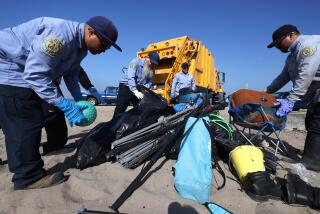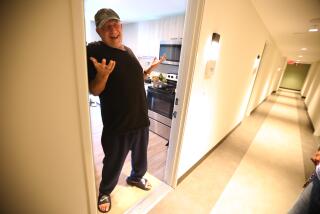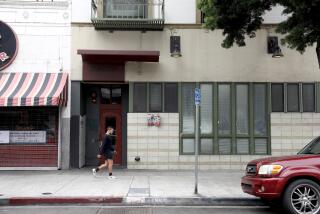Los Angeles skid row cleanup nets nearly 5 tons of refuse
Hundreds of hypodermic needles, gallons of human waste and numerous dead rats: These were among the items cleared from the streets and sidewalks of Los Angeles’ skid row neighborhood during a 13-day sweep that wrapped up Friday, according to city officials.
The cleanup was launched in response to a Los Angeles County report citing public health dangers in the area.
In all, nearly five tons of trash and more than 81 cubic yards of wastewater were collected from six miles of roadway and sidewalks between 5th and 7th streets and Gladys Avenue and Wall Street, said Michelle Vargas, a spokeswoman for the city Department of Public Works. The haul included soiled mattresses, sofas, wheelchairs and portable commodes.
City workers also removed 278 hypodermic needles, 94 syringes, 60 razor blades, 10 knives, 11 items of drug paraphernalia and a stash of marijuana, Vargas said. Most of the needles were recovered from San Julian Street, between 6th and 7th, an area where police say drug dealers and their clients congregate.
Two 5-gallon buckets of feces and three similar-sized buckets of urine were found in a nearby block of 6th, where a more entrenched homeless encampment had formed, Vargas said.
City officials had said cleaning crews had been hampered by a federal court injunction issued last year that placed limits on the removal of items left unattended on skid row sidewalks. Residents had complained that their property was seized and destroyed while they used a restroom, filled water jugs or appeared in court.
A subsequent buildup of trash, needles and human waste created a health hazard that city officials said they were required to address. Some neighborhood activists accused the city of deliberately allowing conditions to deteriorate to bolster its case against the injunction, allegations denied by the city.
A multiagency task force was assembled to develop policies and procedures that strike a balance between respecting the property rights of the homeless and ensuring that people can live and work safely in the area, said Patrick Butler, an assistant chief with the Los Angeles Fire Department who served as operations manager for the effort.
Notices were posted on walls, and teams assembled by the Los Angeles Homeless Services Authority canvassed the area to ask people to remove their belongings during the cleaning. In the process, at least 14 people were provided shelter and other types of help, said the authority’s executive director, Michael Arnold.
The city also paid for an additional 500 storage bins at the Check-In Center, a warehouse run by the Central City East Assn. business improvement district. The facility, which had been operating at capacity for years, can now accommodate the belongings of 1,134 people for free.
Items recovered during the sweep that were not deemed a biohazard were bagged, tagged and sent to a city storage facility, where their owners have 90 days to retrieve them. A total of 30 bags were collected, with items including medicine bottles, checkbooks, identification documents, clothing and at least one watch, Vargas said. Three shopping carts and a walker were also sent to the facility, she said. So far, just one bag has been claimed.
Many residents welcomed the cleanup, although neighborhood activists expressed concern that it might be followed by stricter enforcement of a city regulation that bars items from being stored on the pavement. Pete White, co-director of the Los Angeles Community Action Network, a longtime critic of the city’s efforts to clean up skid row, said resources would be better spent addressing the “root causes” of homelessness.
Members of the city task force plan to meet this week to review the effort and develop a maintenance plan. Although the area was noticeably cleaner after the sweep, discarded food containers and streaks of urine were already reappearing on some of the more crowded streets.
More to Read
Sign up for Essential California
The most important California stories and recommendations in your inbox every morning.
You may occasionally receive promotional content from the Los Angeles Times.









